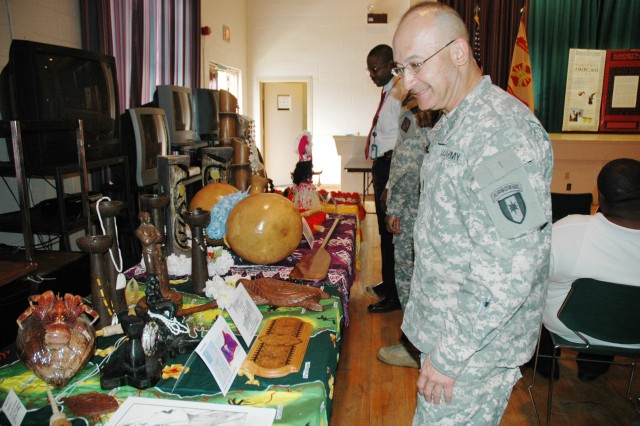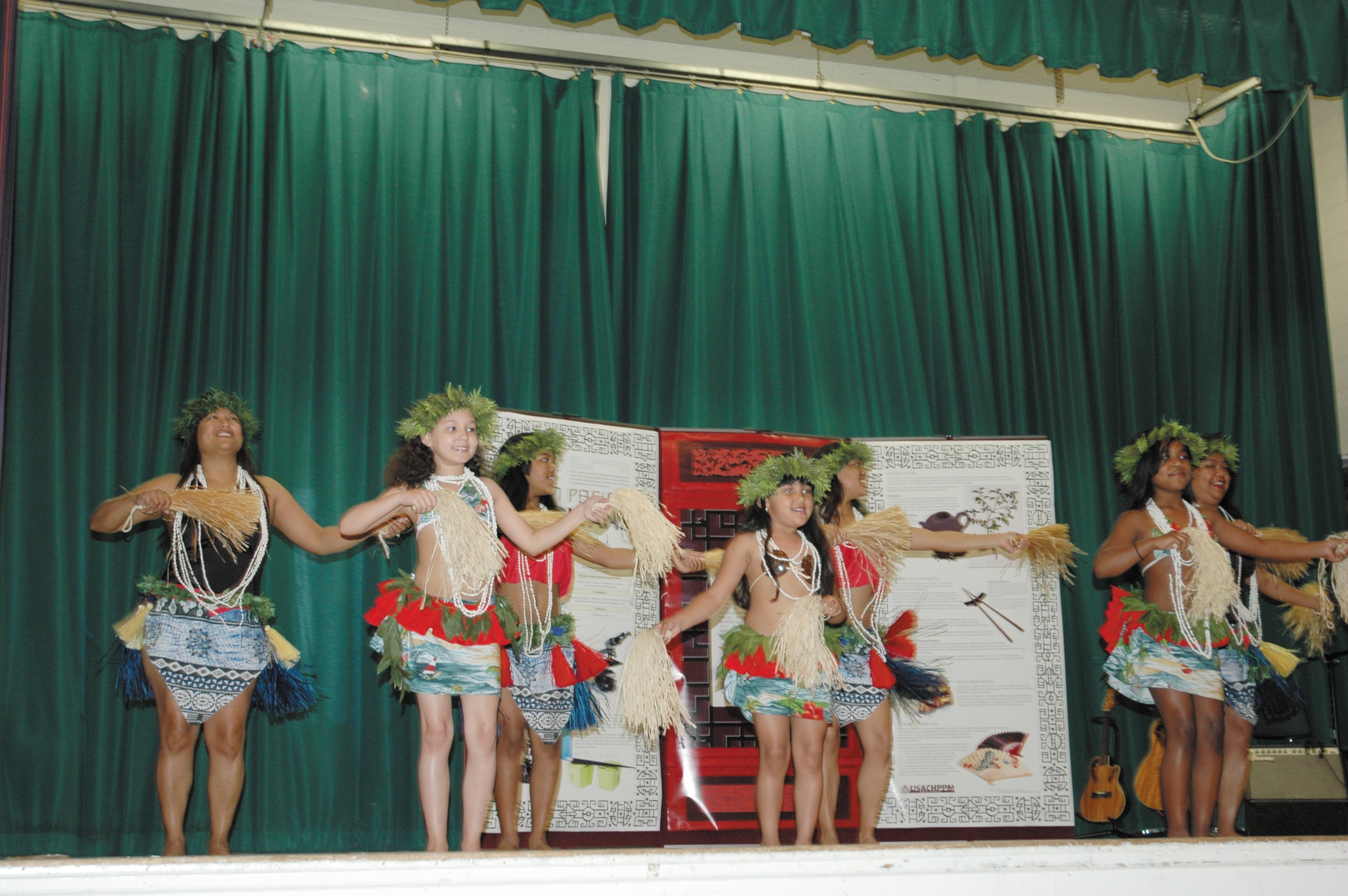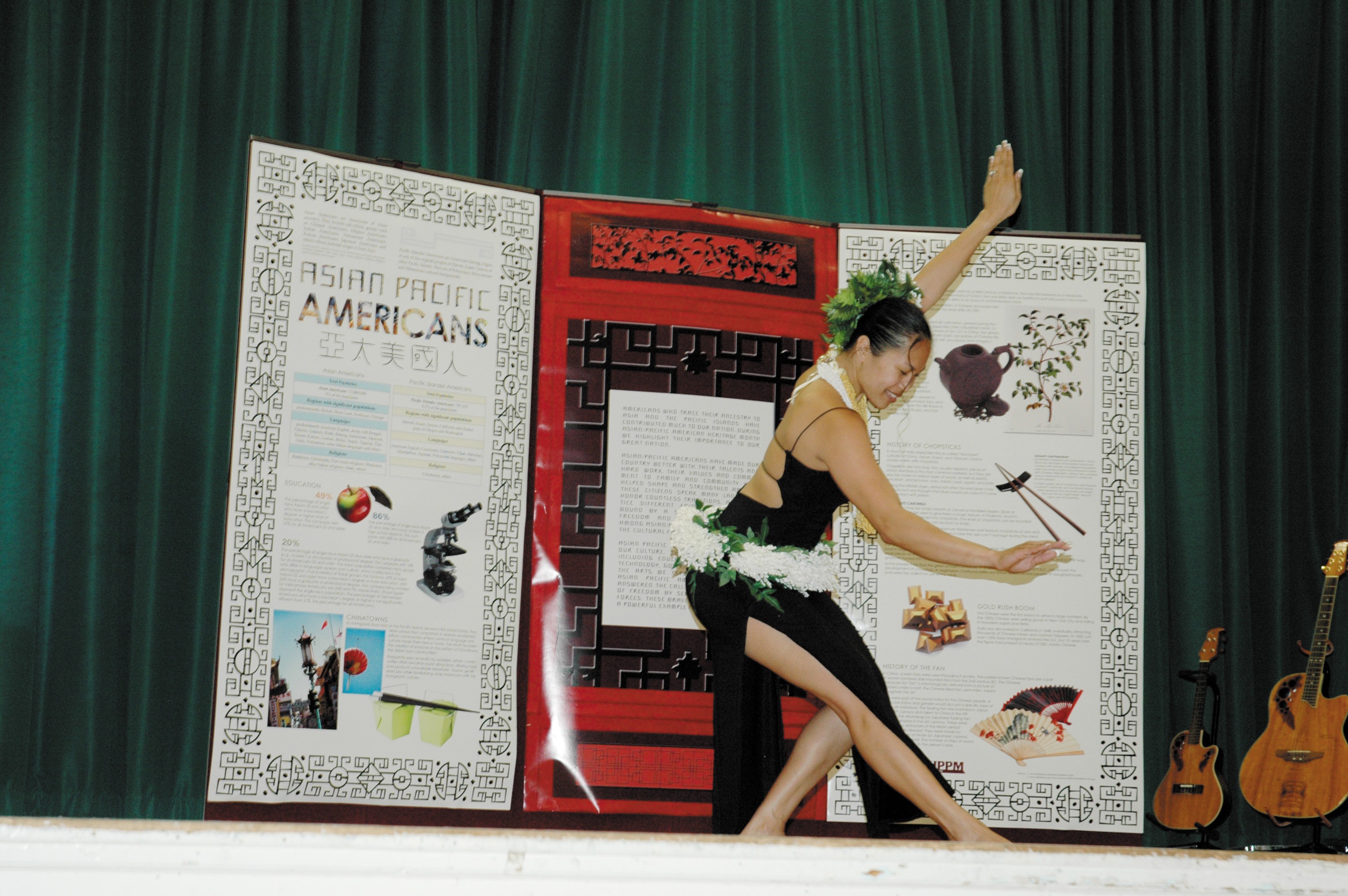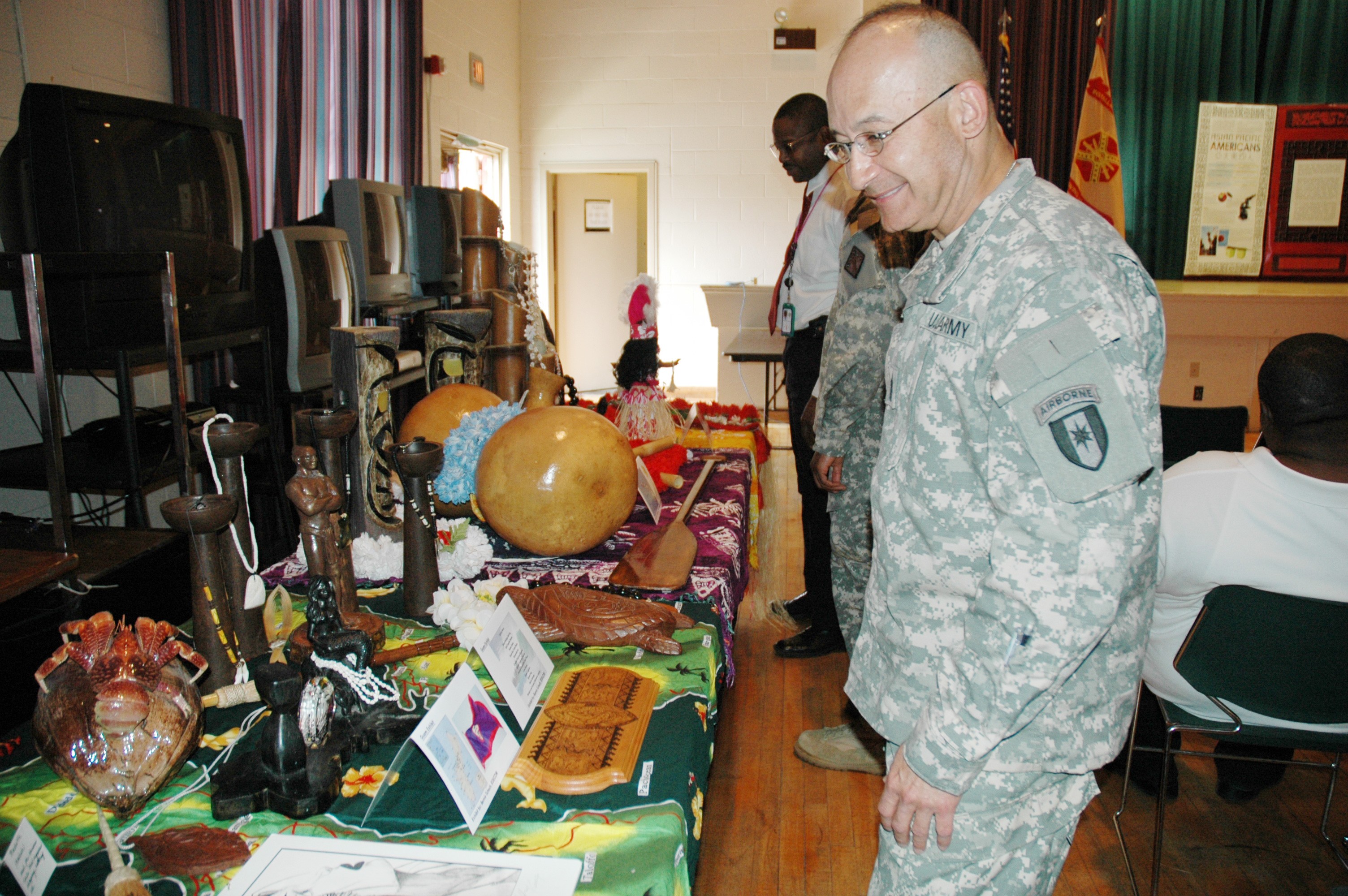Asian-Pacific culture was celebrated with song, dance, exotic food and colorful artifacts during the Asian-Pacific American Heritage Month observance at the Edgewood Area Stark Recreation Center May 12.
To open the program, Chaplain (Maj.) Young Kim gave the invocation, and Sgt. Anthony Gentilo from the U.S. Army Materiel Command Band sang the national anthem.
Bernadita Schech, a human resources specialist with the U.S. Army Research, Development and Engineering Command, G-1, was the mistress of ceremonies.
Schech said that Asian-Pacific Americans are a diverse group of people and encompass many different languages, religions and cultural traditions. Asian Americans include sub-ethnic groups such as Chinese Americans, Filipino Americans, Indian Americans, Vietnamese Americans, Korean Americans, Japanese Americans and others whose national origin is from the Far East Asia, Southeast Asia and Indian sub-continent. Pacific- Islander Americans include those of Polynesian, Micronesian and Melanesian cultural backgrounds which includes Hawaii, Guam, Samoa, Tahiti, New Zealand and many other islands.
After Schech's remarks, there was a fashion show displaying attire from some of the Asian countries and Pacific islands.
Following the fashion show, Capt. Russell Untalan, from 20th Support Command, sang four Hawaiian songs while playing the ukulele and the guitar. He dedicated his last song to Soldiers and civilians who are deployed.
After Untalan's songs, his wife, Diane Untalan, danced a hulu dance, "Palehua." This dance tells the story about a majestic mountain called Palehua, whose breezes are so gentle and fragrance so enchanting, it was unveiled to the heavens.
Untalan also performed the "Etui/Terina." This dance medley comes from the island of New Zealand. The first song tells about the attractive Tui Bird, whose vibrant colors and beautiful melodies can be heard throughout the jungle forests. The second song offers a blessing to a little girl, Terina, praying that she will grow and grace. This is danced with the Maori Poi ball, and was used many years ago by the indigenous Maori people of New Zealand to increase their flexibility and strength in their hands and arms as well as improve coordination.
A visiting Asian-Pacific dance group, The Pacific Islanders, also performed several dances, like the Hano Hano dance with split bamboo sticks that keep rhythm, and the Hawaiian War Chant, a traditional Hawaiian dance with feathered gourds.
After the dance performance, Col. Jeffrey S. Weissman, garrison and deputy installation commander, gave remarks stating that Asian-Pacific Americans represent approximately two centuries of immigration to America from more than 50 countries and islands.
"We appreciate the unique qualities of Asian-Pacific Americans," he said. "They speak many languages, honor countless traditions and practice different faiths, but they share a commitment to freedom and liberty. We especially honor those Asian-Pacific Americans who protect the cause of freedom and serve in our armed forces. They set a powerful example for all Americans.
"As we learn more about people of different cultures, we start to get a better understanding of ourselves," he said "We come to realize that there is more that unites us than divides us. And that is the essence of America."
Weissman introduced the guest speaker, David Lee, the executive director of the governor's office on Asian-Pacific American Affairs.
Lee was appointed executive director of the Governor's Office on Asian-Pacific American Affairs in May 2006. He is Gov. Martin O' Malley's liaison to more than 250,000 Maryland residents of Asian-Pacific American heritage. In this capacity, Lee has organized a number of events and initiatives to address the needs of the Asian-Pacific American community in such areas as business, healthcare, education, aging, and emergency preparedness. Recently, he led a coalition of community leaders to convene the first-ever Governor's Asian-Pacific American Summit in Annapolis, Md.
Lee said that since the Spanish-American War, Asian-Pacific Americans have risked or sacrificed their lives for their country, and today Asian-Pacific Americans are making significant contributions in service to their country in Iraq and Afghanistan.
Lee said that retired Gen. Eric Shinseki, a Vietnam War veteran and former Army Chief of Staff, is one of three Asian-Pacific Americans serving in President Barrack Obama's Cabinet.
"It is fitting to set aside a time each year to reflect on these contributions," Lee said. "It is an opportunity to educate and remind ourselves about the role that Asian-Pacific Americans play in the life of our nation today and the challenges that they have faced and overcome."
Lee added that it is important to celebrate America's diversity.
"It's important to recognize the great diversity of our nation, the history and background, the cultures and heritages, the struggles and accomplishments - not only recognize it, but to embrace it," Lee said. "Governor, Martin O'Malley often says, in Maryland, our diversity truly is our greatest strength.'"
After Lee's speech, Weissman thanked the program's organizers and participants and presented awards to the winners of the Asian-Pacific display contest. First place winner was Ladonna Sparks, U.S. Army Ordnance Mechanical Maintenance School, and runner up was Basic Noncommissioned Officers Course Class 26-09 52D and 63B.
Weissman recognized committee members Linda Patrick, U.S. Army Center for Health Promotion and Preventive Medicine; Sgt. 1st Class Elwood Veney, RDECOM; Master Sgt. Michelle Davis, 20th Support Command; Master Sgt. Gail Brennan and Sgt. 1st Class David Pickett from the U.S. Army Ordnance Center and Schools; Staff Sgt. Wendy Spohn, U.S. Army Materiel Command Band; Linh Phan, Renu Rastogi, and Uday Metha from the Edgewood Chemical Biological Center.
After the program, attendees sampled food from Asian-Pacific countries, including vegetable lo mein, teriyaki chicken, vegetable sushi from Japan, spicy green coriander chutney, tamarind chutney, and somosas from India, curry chicken, kimchee, vegetable pakora, and bulgogi fried rice, and chicken satay from Korea, chicken kelaguen, and Bibingka from Guam.
Diane Untalan, who is originally from Guam, said that she enjoys dancing because it is a way she can celebrate her culture with others.
"The military is made up of so much diversity so I think that events like these celebrating cultural diversity are important," she said. "I love to dance, and my culture is part of who I am."
Liz Williams, who leads The Pacific Islanders, which is composed of her Family members, said that her group frequently performs for universities and for parties.
Sgt. Maj. Gerardo Soto from the 9th Area Medical Laboratory, said that he enjoyed the event.
"The organizers put a lot of effort into the program," Soto said. "It was educational as well as entertaining. I didn't know that the Pacific Islands are so diverse. I think that this [program] is a great opportunity to see the culture and to learn more."
The flyer, posters and programs were designed by Christine Graber, CHPPM photographer and videographer. The large Asian Heritage display was designed by Jason Embrey, CHPPM graphic artist.






Social Sharing